Fields of snow and tranquil trees in snow
Through veils of twilight, northern, still and sad,
Waiting for night, and for the moon
Riding the sky and turning snow to beauty.[1]
Monday, January 12. A grey mist on the day’s face, with apologies to Mr. Masefield. What a dark fall and early winter this has been, cold too, now. Hal Borland was right when he wrote that ‘as the day lengthens, the cold strengthens.’ This morning is a brief reprieve, grey again but calm and mild, impossible to resist taking the camera into the garden.
Many years ago, disenchanted by a long winter I wrote:
My conclusion is that no gardener of ambition and conviction would, in our climate, give more than a secondary importance to the winter garden, would seek a lesser mediocrity from December to April if that in any way imperiled the magnificence that can be ours during the other months. Spring, summer, fall are necessary, winter only contingent.
I do not remember why I was feeling quite so grouchy (‘after three months the peeling bark of Acer griseum may be as boring as a flat expanse of grubby snow’), but grouchy I was: ‘the reality is…of dirty snow, icy ruts, exposed frozen soil, of freezing rain, terrifying winds and broken branches,’ and I could have added more (and did: ‘Winter is the icicle in the soul of the gardener’).[2]Seventeen-and-a-half winters have softened my stand. I don’t exactly rejoice in winter, but I can now see merit in the winter garden. Success in creating a garden depends more on luck than we are normally prepared to admit; it rains at the right time, doesn’t get cold at the wrong, squirrels don’t eat the bulbs, lily beetles don’t exist. But over a long period, getting the bones in place, choosing the appropriate plants, all that translates into something that overrides chance unless one is an unhappy victim of floods or tornadoes.
The bones at Lilactree Farm have always meant hedges and fences and lines of trees; resources were never available for stone walls, brick or stone paths and steps, water staircases and major sculpture, seismic earth-moving projects or fountains constructed around giant mythical figures. Much shaping has been achieved by subtracting rather than building, so that vegetation not removed became defining boundaries. In a snowy winter the hedges and fences not only create micro-climates, softening the harshness of winter winds, but they gain added garden value from the shapes, forms, patterns that they impose upon the landscape, while the paths gain greater penetration into the surrounding landscape through the absence of leaves and the clarity of winter light.
The New Field Path is edged, halfway up the rise, by Malus sieboldii, the Toringo crab, a late-flowering Japanese crabapple with pink-turning-white flowers and a profusion of small bright-red fruits; beautiful in flower, ebullient in berry. The Profusion Allée is approached from the east through Douglas firs that give way to Malus ‘Profusion’, a cultivar whose name indicates its generous dark-red flowering, but this is not a crabapple that I would choose if I were planting anew; there are better varieties, suffering less from late-season disfiguring scab.Other significant paths are the Pine Path, the Maze Path and the Blue Bench Walk. The latter is, in a sense, ‘hedged’ by the peonies that grow along the sides but the other two depend for their definition on tree plantings with unmown grass forming the ‘hedges’. The Pine Path is lined with Amur Cork trees, Phellodendron amurense, one of those lucky choices referred to earlier – they simply came easily from seed and are happy on alkaline soils – with fissured corky bark and soft yellow fall foliage that shines gloriously in pale autumn sunlight.The Maze path is a narrow, mazy mix of species – crabapples, lindens, sorbuses, a Chinese catalpa with a scent so powerful it must drive a dendrophile dotty with desire. In summer, these tree-clad paths provide shelter from the heat of the sun, are homes for nests, and rustle in the wind.In English gardening books, snow on hedges is usually shown as a kind of icing sugar that barely conceals the green beneath. Our deep snows, often damp and heavy, can swiftly damage improperly trimmed hedges; it is critical that, as far as possible, they be clipped ‘on the batter,’ that is, narrower at the top than at the bottom so that snow will slide from them and not push them open (there is another reason; the bottom of the hedge is less likely to be shaded and die out. You can see good examples here of how we failed to take this counsel). Properly clipped, and before they disappear under accumulated snow, evergreen hedges are reassuring presences, pushing eye and spirit outwards into the surrounding landscape and simultaneously making friendly supportive enclosures on a human scale.The evergreen hedges are all ‘cedar’ i.e., Thuja occidentalis (there are several low-growing hedges, edging rather than sheltering, of Alpine Currant, Ribes alpinum). The Pool Path (below) guides the eye to the small sculpture embedded in the facing hedge; the snow has not yet accumulated, as it will do in some winters, sufficiently to overwhelm the 2m+ [6.5 ft+] hedges.
I seldom walk this path in winter, preferring to leave it free of footprints (of my footprints). Even in summer I like the sense that there is something else at the end of the path, but that something needs to be earned, to be discovered; we must make the effort to get there.The hedges in the accompanying photo serve much of the same purpose, leading the eye, coaxing the stroller in particular directions so that planned shapes and vistas have an impact, but they also have a more specifically ‘architectural’ role, their mass tethering the
space where they have been grown. I love their solidity, their feathery heaviness, black and white like a set for My Fair Lady.Winter brings out the best in many trees; with their leaves gone, they may become dramatic, powerful, nervous, fragile. The Kentucky Coffee tree – its seeds were apparently used as a coffee substitute by the early settlers – develops a craggy, sombre form as it ages,
a stern, solitary sentinel on the Mulmur ramparts, alert for enmity in any form. I discovered a year or two back, after fifteen years of never noticing, that it produced elegant, tiny pale blue flowers.The Japanese Crab, or Tea Crab as it is sometimes known, is in the Anniversary Garden where, with a little help it has developed this candelabra configuration.Its dark, smooth bark is a contrast to its light, effervescent flowering. It, more than any other tree in the garden, turns my thoughts – so early, too early, as the thermometer begins its ugly glissando tonight to minus 24C [-11F] – to the ‘profusion hardly to be counted’[3] of spring.[1] I have lost track of the writer of these lines, and Google was unable to help. If you recognise them, please let me know so that I may properly acknowledge them.
[2] “Secondary Importance” in Essays on Gardening in a Cold Climate, which can be ordered here.
[3] Vita Sackville-West, The Garden.
Past issues of Lilactree Farm Notes can be found here.


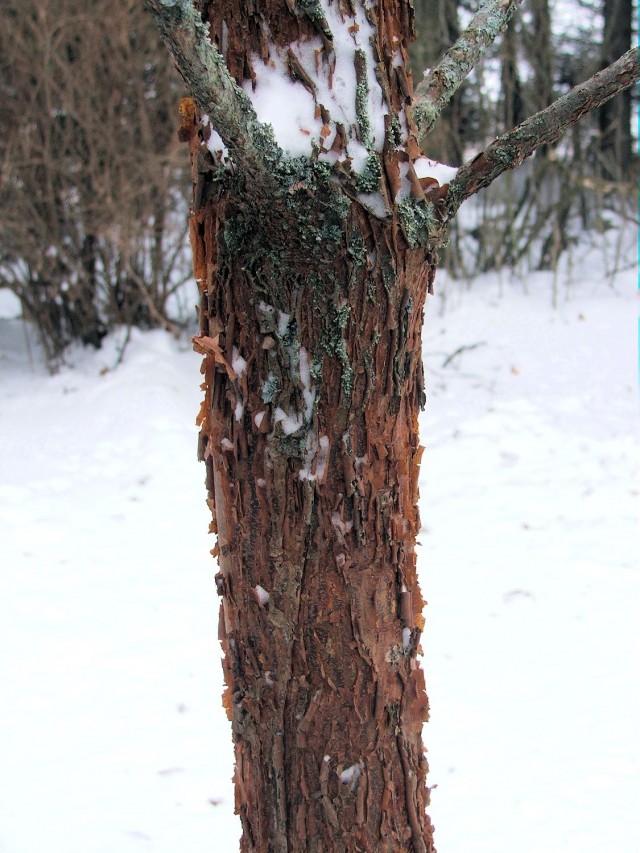
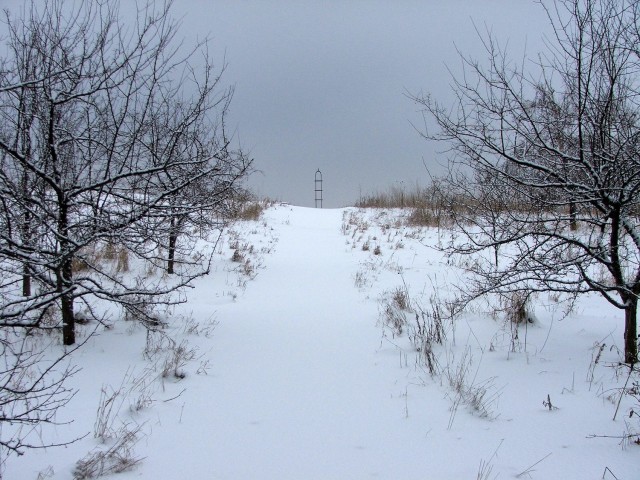
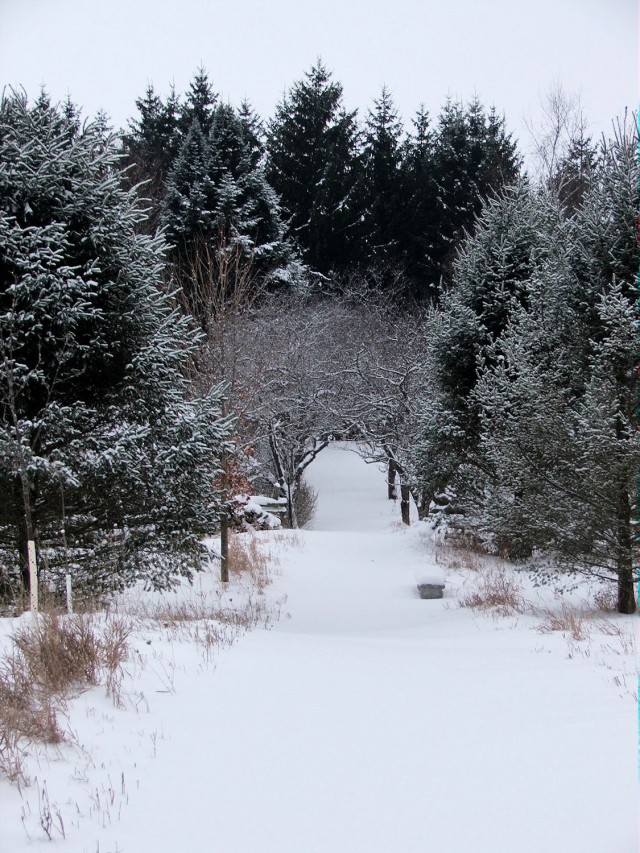
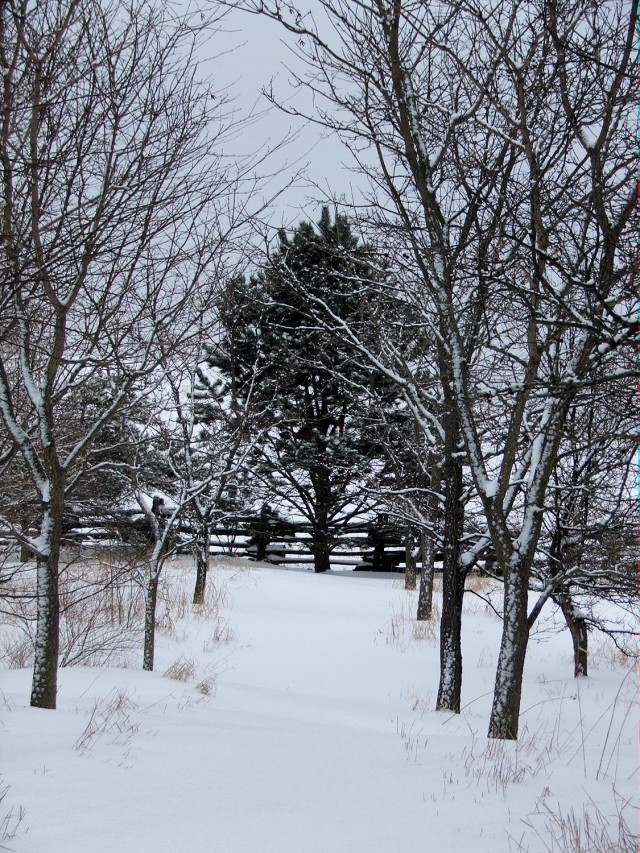
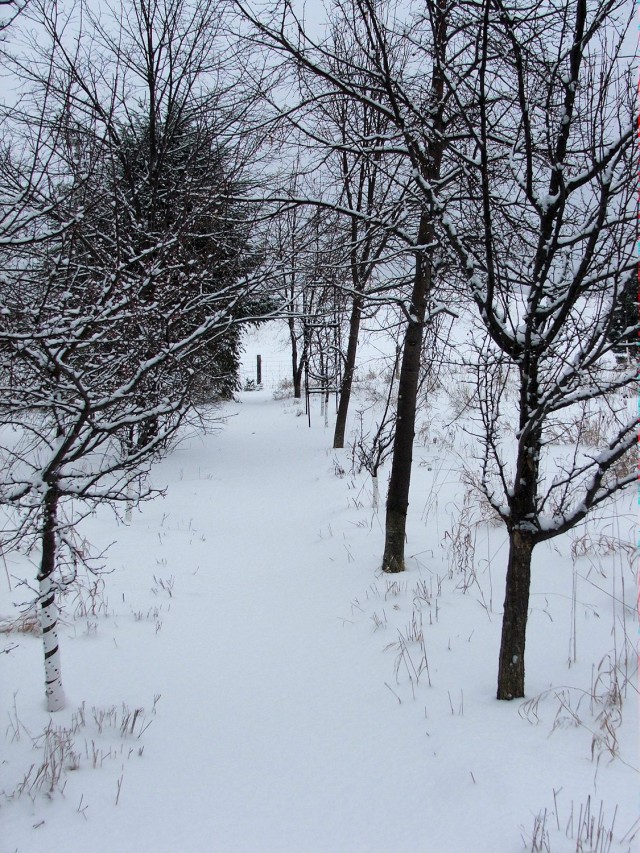
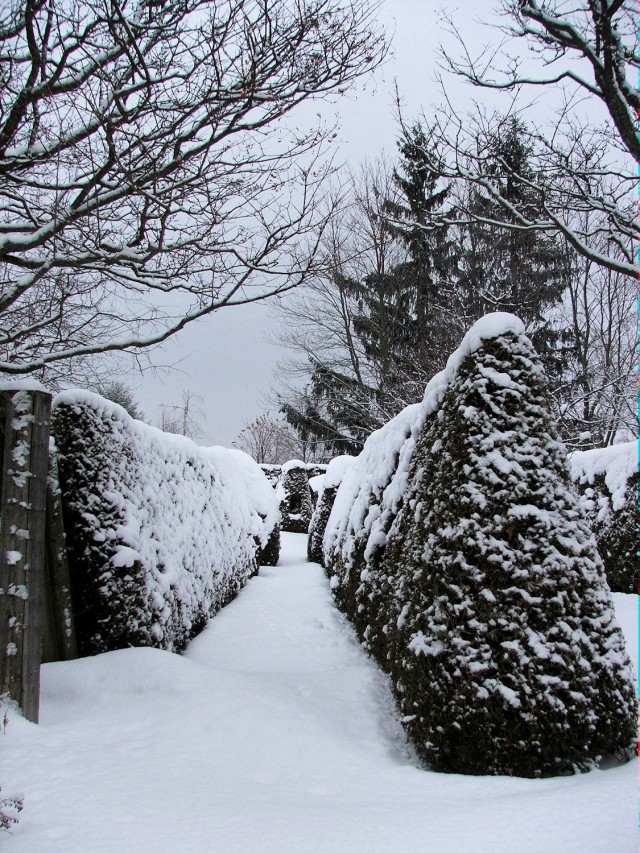
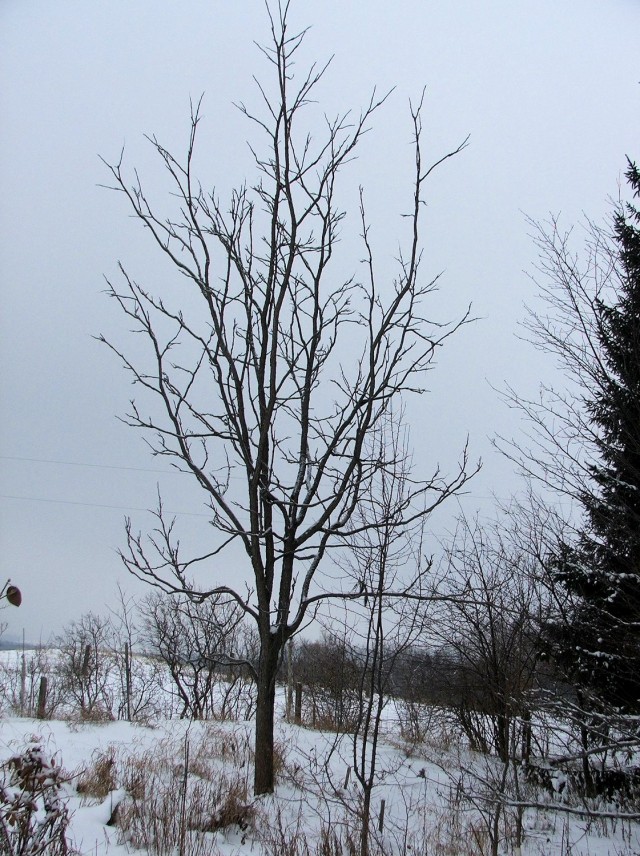
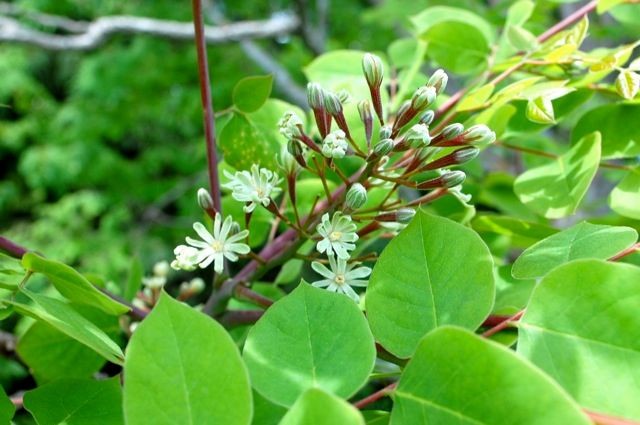
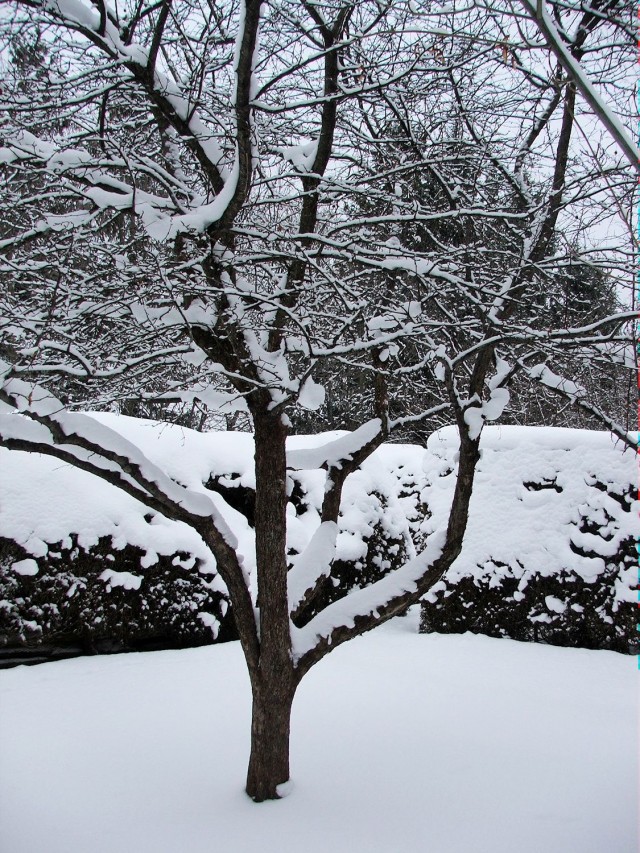



Winter does bring out the best in trees. It seems odd lump descriptives like dramatic and powerful with the word fragile, but last winter’s ice storm was a reminder of just how fragile a tree that reaches several stories can be. I will never forget the thunder of ice covered limbs as they crashed to the ground the December before last.
Jennifer, If, as seems possible, you are referring to the ice storm that hit parts of southern Ontario, forgetting must be difficult. I saw first-hand some of the damage, and friends sent distressing photos of much that I had not. BB
A beautiful post. Those photographs! I think the point is that even in a small suburban garden one can have a wintery focal point, a sculptural tree or some such, that pleases the eye – from a window – and gives pleasure.
You are surely right. We often neglect the view into the garden from the house, and we neglect even more the way the house may be glimpsed from the garden. BB
A lovely read on a winter’s morning. I like the idea of creating shape and definition by subtracting, rather than adding. I will be giving that some thought as I look at my own garden.
Carol, It’s often hard to resist adding yet another element, another bed, another plant, another object, confusing the eye, scrambling the senses. BB
What an elegant essay, Brian. It was the perfect accompaniment to the sunny winter day outside my window in Quebec. I’m looking forward to seeing Lilactree Farm and to walking along those enticing alleés in their summer clothes.
Brian,
Your photos are lovely. Your writing is even more lovely. I hope Kathy will let you visit here again soon.
Robin
Robin, Words to warm up another cold day. Can I encourage you to look at some earlier pieces that Kathy reprinted? You just click on “Past issues of Lilactree Farm Notes can be found here’ up above. BB
Joanne, Thank you. I try not to cast too cold an eye on the winter garden when it’s easy to see the opportunities missed. BB
Brian, that was a lovely read. I didn’t know the Kentucky coffee tree had bloom flowers.T The snow scenes are beautiful. We’ve had very cold weather in Oklahoma these last several months. Today, the sun finally shone, and I was so glad. ~~Dee
Thank you, Dee. Comments like yours and those above and below are very encouraging. BB
Beautiful Post Kathy. I think for those of us who live with such a long season come to see its value and this posts points out many of the things I love about the winter garden.
It is a beautiful post, Don, but I didn’t write it. My guest author Brian Bixley wrote it and it is his garden that is pictured. Just wanted to make that clear.
But, Kathy, we know you COULD have written it. If I am so pleased to have my pieces appear here, it’s because I know I am in such good company. Brian
Beautiful photos and post! You almost make me want snow! Okay, for two days then an easy peasy melt.
No swift thaw here, I’m afraid, Gail, and in any case I don’t want that. We now have a good snow cover, and I would like it to stay like that until the end of March. BB
I wish this icicle in my heart would just melt. I know it will happen soon.
Layanee, Lucky you to know ‘it will happen soon.’ Where I live , it will be another three months. BB
The trees of your garden in winter as shown and the prose that accompanies them are superb.
Frances, Thank you for this. I seem to remember that you wrote kindly about an earlier piece of mine. I’ll keep trying. BB
Wow. Just wow. Loved this post!
Leslie, I love ‘wows’. Thank you so much. BB
You make me feel like I’m missing something down here in south central Texas … when there’s always something growing and blooming, you don’t get that stark beauty your pictures captured. I chuckled at the icicle in the soul … down here, it’s a laser-hot sunbeam in the soul in summer.
Cindy, Right now a ‘laser-hot sunbeam’ sounds pretty good. Thanks for your comment. BB
I would love to walk the beautiful, serene, Profusion Allee. Love Brian’s writing and the garden. A winter garden like this is a beautiful place. Thanks for sharing.
Many thanks, Mary Ann, for kind words. In a piece, From Here to There, that Kathy printed earlier (October 29, 2010) you can see the Profusion Allee in May…BB
There is something quite beautiful in the outline of your garden in the snow. Something beautiful in watching your garden sleep as it turns from bright colors into a black & white world.
I didn’t realize the Kentucky coffee tree was so hardy.
Kathy, Thank you for reprinting my piece. An unanticipated benefit to the Kentucky Coffee tree has been the way it throws out a few suckers that can – not easily- be detached and given away or planted elsewhere in the garden. Brian
Love the trees in winter! I have also been looking at my small garden to see what structures can remain in the winter to give the eye variety. Thanks for the photo walk through your garden.
Joanne, Thank you. I try not to cast too cold an eye on the winter garden when it’s easy to see the opportunities missed. BB